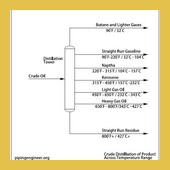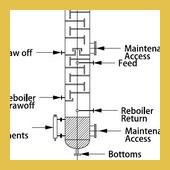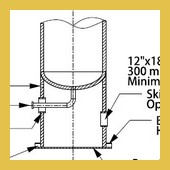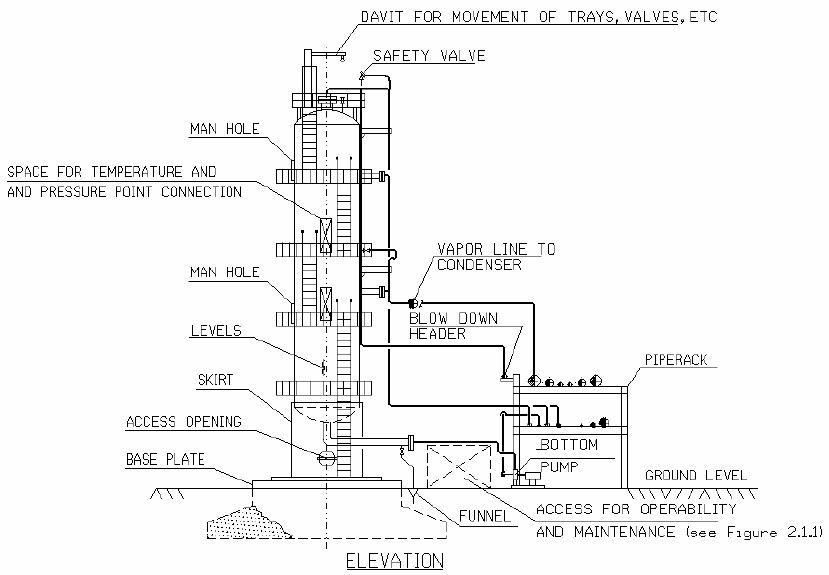Distillation tower is a very sophisticated equipment in a process plant. It separates an input stream into various components based on their boiling point range. Its critical to get their layout right first time as layout of other related equipments is based on them.
 |  | |
| Crude oil in its natural form is of little commercial use. But when it is …Read More.. | ||
 |  | |
| Towers are named for the service or type of unit they are associated with. For example, …Read More.. | ||
 |  | |
| Tower elevation is the distance from grade to the bottom tangent line of the vessel. Support is …Read More.. | ||
Locating distillation towers.
Towers / columns should be located along the pipe rack towards open areas for unobstructed erection as well as maintenance of internals at grade. Tall towers requiring frequent operating attention at upper levels may be located at one place so that common connecting platform can be provided.
Towers and vertical vessels shall be arranged in a row with common centre line, decided by the largest vessels, placing O.D. of the equipment minimum 4M away from the pipe rack.
A minimum clearance of 3M shall be allowed between tower shells, but in any case platforms of adjacent towers shall not overlap (minimum 100 mm horizontal gap shall be provided between platform of adjacent towers) and that a minimum 900mm is left between tower plinths. The gap between vertical vessels shall allow full opening of manhole covers without restriction.
Locating Related Equipments
Towers are not standalone equipment. They need other connected equipments such as Reboilers, Pumps, Reflux Condenser, Air Cooler, Reflux Drum etc.
Thermo-siphon reboilers should preferably be placed close to their associated towers.
Pumps shall be placed near the tower and along the pipe rack. Air cooler is placed above pipe rack as close as possible to distillation tower, considering required flexiblity in vapor line.
Reflux Drum and Reflux condensers are located on a technological structure near the distillation tower.
[google-square-ad]
Setting Elevation of Bottom Tanline
Tower elevation to be set considering NPSH, operator access, maintenance access, minimum clearance and common access.
Platforms and ladders requirements
Distillation towers are very tall equipments and they require platforms at various levels for access and maintenance purpose.
- Manways and platforms shall be located on the access side, with manways on or about the same centerline.
- Maximum Ladder Length shall be 9 Meters.
- Access platforms/ladders shall to be provided along the column for valves and instruments.
- Platform width shall be such that minimum 1M space is available beyond manhole for movement.
- Minimum clear width of platform shall be 750mm.
- For ease of operation and maintenance, column and vessels which are grouped together, shall have their platforms at the same elevation and should be interconnected by walkways.
- However each column / vessel shall have an independent access also.
- Column / vessel platforms should be designed in such a way so that all the nozzles should be approachable from platforms.
Manholes
Manhole should not be towards downcomer. They should open on tray. Manholes shall be kept on the road side of the column and shall be approachable from the platform.
Interconnecting Platforms
Efforts shall be made to provide interconnecting platforms at suitable levels for adjacent towers and/or adjacent technological structures & rack walkways etc. Combined platforms shall be furnished, when practical or economical, on lined-up towers with common manway elevations.
Interconnections, wherever feasible shall be done after taking thermal expansions of towers into considerations.
Piping Layout.
Piping at columns shall be located, where possible, radially about the column on the pipeway side. Valves and flanges shall not be located inside vessel skirts.
Vents, drains and utility connections shall be arranged to prevent unintentional or undetected leakage. Piping from column shall drop or rise immediately upon leaving the nozzle and run parallel and close as practicable to vessel.
Reboiler outlet piping shall be as short as possible with minimum bends. Piping at columns/vessel nozzles shall be arranged so that blanks can be easily installed for hydrotesting.
Unless specifically indicated in P&IDs control valves shall preferably be kept at grade. Piping intended for vacuum services shall be routed as short as possible with minimum bends and flanged joints.

Davits
Maintenance of distillation tower mostly includes removal of trays, control valves, pressure safety valves etc. to ground for maintenance.
Davits or other suitable means shall be provided to lower pressure vessel relief valves larger than 2″ inlet size when not within reach of mobile equipment.
Vessel davits for handling internals, relief valves and other components, shall be provided on vessels exceeding a height of 15000 mm above finished surface, and on vessels not accessible by mobile crane. Davits shall be oriented to allow the lowering of appurtenances into the access area.
Vessels, column, Reactors with internals and / or containing catalysts, chemicals etc should have a drop-out area for removing / installing the internals and / or for loading / unloading of catalysts and chemicals.
Instrumentation
Temperature instruments should be in liquid space, downcomer side. Pressure instruments shall be in vapor space, opposite of downcomer.
All level switches, LGs etc including their isolation valves shall be accessible from ladders or platforms.
 |  | |
| Supporting of pipes on a distillation tower is a critical activity involving stress analysis of …Read More.. | ||
